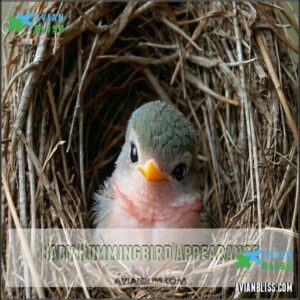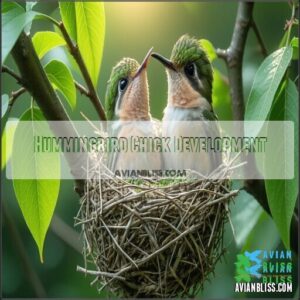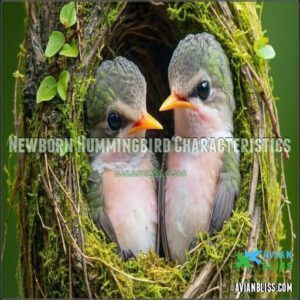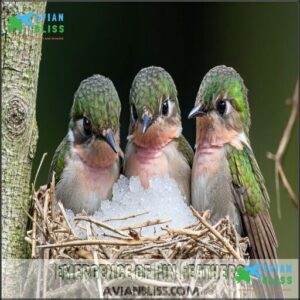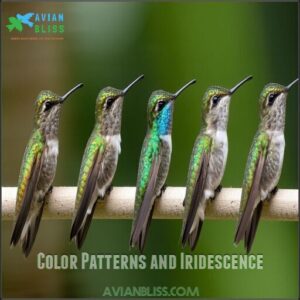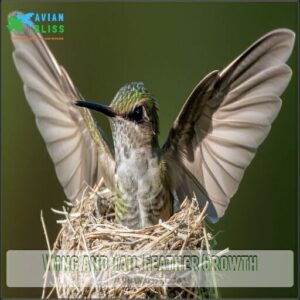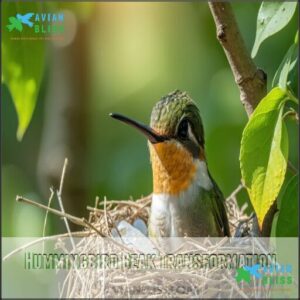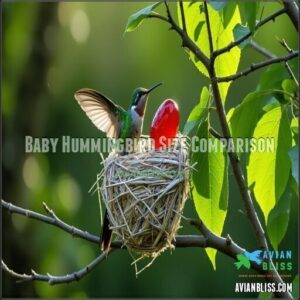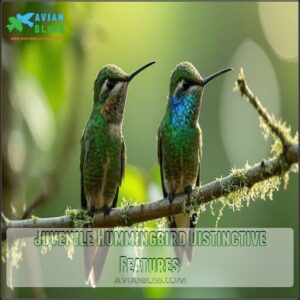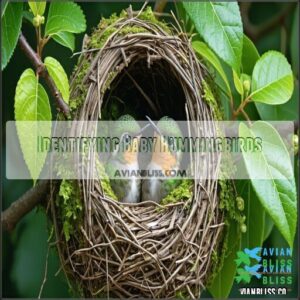This site is supported by our readers. We may earn a commission, at no cost to you, if you purchase through links.
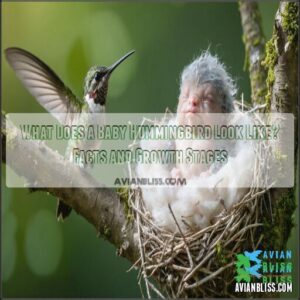
These tiny creatures emerge from eggs smaller than jellybeans, measuring just 1/4 inch long and weighing less than a paper clip (0.5g).
Newborns are featherless with pinkish-gray skin that looks almost translucent.
Their eyes remain closed for about a week, and their beaks are remarkably short—nothing like the specialized nectar-sipping tools they’ll develop later.
Imagine a wrinkled pink bean with a stubby beak and tiny bumps where wings will grow.
The transformation these vulnerable chicks undergo in just three weeks is nothing short of miraculous.
They develop from a state of complete dependence into a form that is ready to take on the world, with remarkably short beaks giving way to more functional ones, and their overall appearance changing dramatically, making their development a truly vulnerable process.
Table Of Contents
- Key Takeaways
- Baby Hummingbird Appearance
- What Does Baby Hummingbird Look Like
- Hummingbird Chick Development
- Newborn Hummingbird Characteristics
- Baby Hummingbird Feather Growth
- Hummingbird Beak Transformation
- Baby Hummingbird Size Comparison
- Hummingbird Chick Behavioral Changes
- Juvenile Hummingbird Distinctive Features
- Identifying Baby Hummingbirds
- Frequently Asked Questions (FAQs)
- What does a baby hummingbird look like?
- What do hummingbirds look like when they hatch?
- How much does a baby hummingbird weigh?
- What is a baby hummingbird?
- What color are hummingbirds?
- How do hummingbird babies differ from other baby birds?
- How do you tell a baby hummingbird?
- What do juvenile hummingbirds look like?
- What month do hummingbirds have babies?
- Why do we not see baby hummingbirds?
- Conclusion
Key Takeaways
Here are 4 key takeaways about what baby hummingbirds look like:
- You’ll be surprised by their tiny size – newborn hummingbirds are smaller than jellybeans, weighing less than 0.62 grams (lighter than a paper clip) with pinkish-gray or dark skin that appears almost translucent.
- Don’t expect to see feathers at birth – hatchlings emerge completely naked with closed eyes and remarkably short, yellowish beaks that bear no resemblance to the specialized nectar-sipping tools they’ll develop later.
- You’ll notice dramatic changes within three weeks – pin feathers emerge around day 7-10, eyes open around day 9, and their beaks gradually elongate as they transform from vulnerable pink beans to recognizable birds ready for their first flight.
- You’ll rarely spot babies in the wild – they remain hidden in well-camouflaged, walnut-sized nests made of plant fibers and spider silk, with their distinctive appearance (shorter beaks, duller plumage) helping them blend in until they develop adult coloration around 4-6 months.
Baby Hummingbird Appearance
You’ll be surprised to learn that newborn hummingbirds look nothing like their colorful parents, starting life as tiny, featherless creatures about the size of a coffee bean with pinkish-gray skin and closed eyes.
Newborn hummingbirds begin as tiny, featherless wonders, no bigger than a coffee bean, with delicate pinkish-gray skin and closed eyes.
At birth, these minuscule birds weigh less than a dime and have short, yellowish beaks that will gradually elongate as they develop over their three-week journey to fledging, which is a critical period for their growth and development into the colorful birds they will become.
Size and Weight
When you first glimpse a baby hummingbird, you’ll be amazed at its tiny dimensions.
Newborn hummingbird size is remarkably small, weighing just 0.62 grams—lighter than a dime.
These hatchlings measure only about one inch in length, fitting perfectly in their quarter-sized nests.
Growth rate varies among species, with the bee hummingbird remaining the smallest at 2 grams, while other species reach up to 20 grams as adults, and have a remarkably small size, with some weighing as little as 0.62 grams.
Featherless and Blind at Birth
When hatchlings emerge, they’re completely blind with their eyes sealed shut for approximately 9 days.
Unlike many birds, baby hummingbirds lack any downy feathers, leaving them utterly naked and vulnerable. Their initial dependence on mom isn’t just for food—it’s for warmth too, as they can’t regulate their own body temperature without feathers.
- Seeing these tiny, helpless creatures makes you marvel at how something so vulnerable can survive
- Their paper-thin skin reveals delicate blood vessels, creating an almost transparent appearance
- The blind nestlings turn their heads enthusiastically toward any vibration, trusting completely in their mother’s care
- Their bare existence feels like nature’s leap of faith—from defenseless pink bean to flying jewel
Skin Color and Texture
While blind and featherless, baby hummingbirds have distinctive skin coloration you mightn’t expect.
Their skin appears dark gray, black, or sometimes pink, with peculiar yellow straw-like strands running down their backs. This texture isn’t fuzzy like other baby birds—it’s smooth and delicate.
After about 10 days, you’ll notice their skin developing pin feathers resembling tiny porcupine quills, marking the beginning of their transformation.
Beak Shape and Size
While adult hummingbirds are known for their long, specialized bills, a baby hummingbird’s beak looks remarkably different.
You’ll notice their beaks start quite short and yellowish, gradually elongating as they develop:
- Initially just 1/8 inch long, resembling a tiny triangle
- Wide "gape width" for receiving regurgitated food
- Yellow coloration, particularly at the edges
- Lacks the distinctive curve of adult bills
- Species variation affects final beak development
The beak’s color will eventually shift, and throat color changes help identify the species. The development of a hummingbird’s beak is a notable example of specialized growth.
What Does Baby Hummingbird Look Like
A baby hummingbird looks nothing like the jewel-toned flyers you’re familiar with.
At birth, these tiny creatures resemble plump raisins or coffee beans, measuring just 1/2 to 3/4 inch long.
They’re born with black or grayish bodies, completely featherless and blind, with distinctive yellow straw-like strands running down their backs.
You’ll notice their skin is often pink or gray, and their beaks are surprisingly short – nothing like an adult’s specialized feeding tool.
Some species feature unique adaptations for nestling camouflage, like the White-necked Jacobin chicks in Panama that hatch with fluffy down feathers resembling dangerous caterpillars – a remarkable mimicry adaptation.
Regional variations exist among species, but all share the characteristic tiny size that makes hummingbird hatchling identification challenging.
Their nests, often smaller than walnut shells, provide perfect camouflage for these vulnerable babies.
These vulnerable babies rely on their nests for protection, and the nests’ small size is a key factor in their survival, making hummingbird hatchling identification even more difficult.
Hummingbird Chick Development
You’ll witness remarkable changes as these tiny creatures transform from raisin-sized, featherless hatchlings to fully-feathered flyers in just 4-5 weeks.
Their rapid development includes opening their eyes around day 9, growing pin feathers after 10 days, and stretching their wings by day 15 before taking their first flights at approximately 3 weeks old, which marks a significant point in their rapid development and growth into fully-feathered flyers.
Initial Growth and Development
Tiny miracles, baby hummingbirds emerge as jelly bean-sized hatchlings, measuring just half an inch long.
During their first weeks, these nestlings experience remarkable weight gain, growing several times their birth size thanks to protein-rich insects and nectar from mom.
The complete journey—from nest building through incubation (16-18 days) to fledging—takes approximately six weeks.
This rapid hummingbird chick development showcases nature’s extraordinary design in these miniature marvels, highlighting the remarkable growth of these birds.
Feather Development Begins
Around day 7, the miracle of pinfeather emergence transforms baby hummingbirds from naked to noticeable. These early feathers resemble tiny porcupine quills emerging from their delicate skin.
Feather development follows this pattern:
- Dark pinfeathers first appear along the back and wings
- Primary wing feathers develop next, preparing for future flight
- Downy body feathers grow last, providing essential insulation
This plumage development marks the beginning of their transformation from vulnerable hatchlings to recognizable birds. Juvenile hummingbirds often resemble adult females, which is a critical phase in their growth and eventual ability to fly.
Eyes Open and Increased Activity
As pin feathers emerge, baby hummingbirds undergo another exciting change – their eyes begin to open! Around day 9, these previously blind nestlings start experiencing their world visually.
At around day 9, baby hummingbirds open their eyes and see their world for the very first time—a tiny miracle unfolding in the nest.
You’ll notice increased activity as their motor skills develop and environmental awareness grows.
| Development Stage | Vision Status | Activity Level |
|---|---|---|
| Days 7-8 | Eyes opening | Low, mostly resting |
| Days 9-10 | Vision developing | Moderate, more alert |
| Days 11-14 | Full vision | High, responsive to surroundings |
With sensory input now including sight, hummingbird nestling features become more apparent as they respond to movement and shadows in their environment, utilizing their developing vision and increasing activity level to interact with their surroundings.
Preparing for Fledging
As young hummingbirds approach the three-week mark, they begin preparing for their big debut outside the nest.
During this pre-fledging stage, you’ll notice these changes:
- Wing muscles strengthen through constant stretching exercises that look like tiny push-ups
- Immature hummingbird wings develop rapid movement capability, practicing in short bursts
- Hummingbird juvenile behavior includes "hovering" while still in the nest, building flight skills
Wing strength determines when they’ll attempt nest departure, usually around day 21.
Newborn Hummingbird Characteristics
You’ll be amazed to discover that newborn hummingbirds weigh less than a dime at just 0.62 grams and measure only about an inch long with pink or gray skin.
Their tiny bodies lack feathers at birth, with closed eyes and short yellowish bills that bear little resemblance to the elegant beaks of their parents, having tiny bodies.
Weight and Length
As baby hummingbirds emerge from their eggs, they’re remarkably tiny creatures.
You’ll be amazed that these hatchlings weigh just 0.62 grams—roughly one-third of a dime’s weight.
Their measurement challenges stem from their diminutive size, comparable to jellybeans or pennies.
Despite their small hummingbird hatchling details, their growth trajectory is impressive, gaining about 0.5 grams daily.
By day 18, they’ve increased their mass by 50%, yet remain so light they can’t stand on their tiny feet.
Their initial diet consists of nectar and insects, essential for their rapid development.
Skin Color Variation
While these tiny creatures weigh almost nothing, their skin color tells a fascinating story.
You’ll notice baby hummingbird skin varies widely from dark gray to pink, sometimes even between siblings in the same nest.
This pigment development serves as both a health indicator and camouflage correlation.
Genetic factors play a major role, but environmental influence can also affect these hummingbird hatchling details.
Their nearly translucent skin highlights their vulnerability during early development.
Distinctive Features
A newborn hummingbird’s distinctive features set it apart from other baby birds.
You’ll notice their yellowish straw-like strands running down their backs, contrasting with their dark bodies. Their tiny feet can’t support standing initially, and they’re born completely blind.
The nestling weight is remarkably light—less than a dime! Their short, stubby beaks bear no resemblance to the elegant probes they’ll develop as adults.
Baby Hummingbird Feather Growth
You’ll notice pin feathers emerging on baby hummingbirds around 7-10 days after hatching, starting as tiny quill-like structures before unfurling into their recognizable plumage.
These feathers develop rapidly, with the nestling’s body becoming fully covered within three weeks, though their distinctive iridescent colors won’t appear until they’re closer to fledging.
Emergence of Pin Feathers
At about a week old, hummingbird chicks start showing pinfeathers—those tiny quills that begin their transformation.
These pinfeathers, encased in a waxy sheath, look like porcupine quills at first but soon soften.
Here’s what to watch for:
- Sheaths Breaking Open: Feathers emerge gently.
- Initial Colors: Often dark or neutral.
- Growth Rate: Rapid over days!
Color Patterns and Iridescence
As pin feathers develop, they reveal the foundation for the hummingbird’s future brilliance.
You’ll notice that iridescence develops gradually in baby hummingbirds, appearing first as subtle hints before maturing into their signature shimmer.
The development of hummingbirds can be categorized into several stages, each with distinct characteristics.
| Development Stage | Color Appearance | Notable Features |
|---|---|---|
| Early Pin Feathers | Dull gray/brown | No iridescence yet |
| Mid-Development | Faint green hints | First structural colors emerge |
| Late Development | Partial shimmer | Species-specific patterns begin |
| Pre-fledging | Increasing brilliance | Gender differences become visible |
| Juvenile Plumage | Subdued iridescence | Camouflage colors predominate |
These stages showcase the gradual development of the hummingbird’s signature colors and patterns, ultimately leading to the mature plumage that characterizes these birds.
Wing and Tail Feather Growth
The transformation of wing and tail feathers marks a critical milestone in a baby hummingbird’s journey to independence.
You’ll notice these flight structures develop through distinct stages:
- Tiny pin feathers emerge along wing edges around day 7-10
- Primary flight feathers extend first, followed by secondaries by day 14
- Tail feathers begin as short stubs that gradually elongate
- Wing shape changes from rounded to pointed as flight capabilities develop
Hummingbird Beak Transformation
You’ll notice that a baby hummingbird’s beak starts short and yellowish, looking nothing like the specialized feeding tool of adult birds.
As the chick develops, its beak gradually elongates and transforms into the perfect instrument for sipping nectar from flowers, which is a key part of its development into an adult with a beak that is a specialized feeding tool.
Initial Short Beak
Unlike their long-billed parents, newly hatched hummingbirds start life with remarkably short beaks.
You’ll notice these tiny bills are yellowish and stubby, resembling small bumps rather than the elegant feeding tools they’ll eventually become.
This initial beak structure is perfectly adapted for receiving regurgitated nectar and insects from mom.
The short size helps guarantee successful feeding while nestlings are still developing their specialized anatomy to eventually become elegant feeding tools.
Gradual Elongation Process
Growing remarkably fast, a baby hummingbird’s beak transforms from short and yellow at birth to nearly adult-like by fledging.
You’ll notice the gradual elongation process happens within just two weeks, when beaks become noticeably longer and darker.
By one month, their beaks are fully developed, completing this vital feeding adaptation, which supports their shift from helpless chicks to nectar-sipping juveniles with increasingly sophisticated bill curvature, showcasing a remarkable example of rapid growth.
Development of Specialized Feeding Structures
As the beak elongates, specialized feeding structures begin to form inside.
You’ll notice tiny tongue grooves developing that will help with nectar uptake.
The baby hummingbird beak gradually develops unique bill curvature suited to specific flower shapes.
Feeding muscles strengthen around day 12-15, improving the chick’s ability to control its tongue for both insect capture and drinking nectar—a remarkable adaptation for the hummingbird chick’s specialized diet.
Baby Hummingbird Size Comparison
You’ll be amazed to discover that newly hatched hummingbirds are roughly the size of a coffee bean or jelly bean, weighing less than a dime at just 0.62 grams.
As they grow, these tiny creatures will double in size within their first week, eventually reaching their species-specific dimensions while their nests stretch to accommodate their rapid development, which is a truly rapid process.
Hatchling Size Relative to Objects
While a hummingbird’s beak continues to develop, it’s fascinating to ponder just how tiny these hatchlings really are.
When you first see a baby hummingbird, you’ll be amazed at their minuscule size.
| Common Object | Size Comparison | Baby Hummingbird Equivalent |
|---|---|---|
| Jellybean | 1/2 inch long | Matches hatchling length |
| Coffee bean | Light and small | Similar in shape and size |
| Dime | Weighs 2.27 grams | Hatchlings weigh under 0.62 grams |
| Walnut shell | Compact and curved | Smaller than the nest itself |
Baby hummingbird appearance is so tiny that you could easily mistake them for raisin-sized insects.
Their walnut-sized nests are equally impressive engineering feats, showcasing the impressive nature of these tiny creatures.
Growth Rate and Weight Gain
The rapid weight gain journey of baby hummingbirds is truly remarkable.
You’ll be amazed at how these tiny creatures develop from birth to fledgling stage.
The growth timeline of baby hummingbirds can be summarized in the following table:
| Growth Stage | Daily Weight Gain | Total Weight |
|---|---|---|
| Newly Hatched | 0.2-0.4g | 0.62g |
| Mid-Development | 0.4-0.8g | 1.8-2.4g |
| Pre-Fledgling | 0.2-0.3g | 3.0-3.5g |
Their growth timeline accelerates with insect protein and nectar intake, reaching fledgling weight in just 3 weeks.
Final Size Differences Among Species
Five different hummingbird species reach dramatically different final sizes. You’ll notice significant variations based on where they live and their genetic makeup.
| Species | Adult Length | Wing Span | Region | Notable Feature |
|---|---|---|---|---|
| Bee Hummingbird | 2-2.4 inches | 1.25 inches | Cuba | World’s smallest bird |
| Ruby-throated | 3-3.75 inches | 4.3 inches | Eastern N. America | Bright red throat |
| Anna’s | 3.9-4.3 inches | 4.7 inches | Western N. America | Pink head feathers |
| Giant | 8.5 inches | 9.1 inches | South America | Largest hummingbird |
| Calliope | 3.1 inches | 4.3 inches | Western mountains | Smallest U.S. species |
Environmental factors like food availability and regional climate influence adult size ranges across species, leading to significant variations in size based on where they live and their genetic makeup, which is a notable feature of these birds.
Hummingbird Chick Behavioral Changes
You’ll notice dramatic behavioral shifts as baby hummingbirds transform from helpless hatchlings to independent fledglings.
Their initial simple begging responses gradually develop into complex behaviors including alert head movements, distinct vocalizations when hungry, and essential pre-flight exercises where they vigorously stretch and flap their tiny wings, which is a part of their complex behaviors and includes distinct vocalizations.
Feeding Responses and Begging
While tiny in size, baby hummingbirds have distinctive feeding responses and begging behaviors.
You’ll notice they instinctively raise their heads when mom returns, responding to her mewing call and wing sounds.
Their begging postures include stretching necks upward with mouths open wide, and the regurgitation process involves the mother pumping food—a mixture of nectar and insects—directly into their throats.
Feeding frequency increases as they grow, with protein-rich insect introduction occurring around day 15, which is a critical part of their development and involves a mixture of nectar.
Increased Alertness and Vocalization
Beyond begging calls, you’ll notice your baby hummingbirds becoming increasingly alert as they develop.
Their vocalization patterns evolve from simple mewing sounds to more complex chirps that serve multiple purposes.
Hummingbird chick appearance changes as they become more active and aware:
- Eyes fully open and track movement across the nest
- Heads pivot quickly toward sounds, especially mother’s approach
- Bodies twitch in response to potential predator noises
- Beaks open wider when vocalizing distress or hunger calls, which can include begging calls.
The development of these behaviors indicates the young hummingbirds’ growth into more active and aware creatures.
Wing Exercises and Flight Preparation
As baby hummingbirds grow more alert, they begin essential Wing Development exercises.
You’ll notice them stretching and flapping their tiny wings while still in the nest, building Muscle Strengthening for future flights.
These movements increase in frequency as Flight Practice becomes their priority.
Around 21 days old, they’ll practice Hovering Ability by lifting slightly above the nest.
Their Independence Day approaches when wing muscles are strong enough for sustained flight—a remarkable bird flight development milestone.
Juvenile Hummingbird Distinctive Features
You’ll notice juvenile hummingbirds display distinctive features that set them apart from adults, including duller plumage colors and unique temporary markings specific to their species.
Their bills are often shorter than adult counterparts, with females and males looking nearly identical until they develop their characteristic adult coloration around 4-6 months of age, which includes duller plumage colors and unique temporary markings.
Differences From Adult Plumage
While young hummingbirds test their wings, you’ll notice their plumage tells a different story from adults.
Juvenile hummingbirds display duller feathers with mottled patterns – nature’s camouflage against predators.
Unlike adults’ vibrant, iridescent colors, baby hummingbird colors appear more subdued, and hummingbird fledgling plumage often resembles adult females, even in sexually dimorphic species.
When identifying baby hummingbirds, look for flecking on the underwings and belly, plus their blackish beaks instead of the brightened adult versions, which can be a key factor in distinguishing them, using their underwings as a guide.
Temporary Markings or Patterns
Juvenile hummingbirds display fascinating temporary markings during their maturation to adulthood.
You’ll notice these distinctive patterns that gradually change as they mature:
- Duller throat patches where adult males will develop bright gorgets
- Speckled or mottled breast feathers that provide camouflage
- Scale-like patterns along the crown that eventually fade
- Light feather edging creating a scalloped appearance on wings
These hummingbird fledgling plumage characteristics help with protection until they develop their permanent adult colors.
Variations Among Different Species
While juvenile plumage appears similar across species, you’ll notice subtle variations that help with identification.
Ruby-throated babies show faint throat speckling, while Anna’s juveniles display greenish flecks on their crowns.
Size variations are considerable too—Costa’s baby hummingbirds are tiny compared to the larger Giant Hummingbird nestlings.
Regional variations in plumage often reflect local adaptations, with tropical species generally showing more colorful juvenile features than their northern counterparts, which can be influenced by subtle variations.
Identifying Baby Hummingbirds
You’ll recognize baby hummingbirds by their tiny size (smaller than a jelly bean), dark skin, and short beaks, often nestled in walnut-sized, camouflaged nests hidden among leafy branches.
When first hatched, they’re featherless with closed eyes, developing pin feathers around day 10 that gradually transform them into miniature versions of their mother, characterized by their overall tiny size and developing features.
Key Visual Cues for Recognition
How can you identify a baby hummingbird when there are so many tiny creatures in nature?
Watch for these key visual cues:
- Pin-like feathers that resemble porcupine quills on a body roughly the size of a coffee bean
- Short, stubby yellow beak that hasn’t elongated yet
- Partially or fully opened eyes around day 9, combined with a distinctive gaping mouth behavior when hungry
The identification of a baby hummingbird relies on observing these key visual cues.
Common Locations to Spot
The most reliable places to spot baby hummingbirds are in their well-camouflaged nests tucked among shady bushes or protected areas.
Look for these tiny treasures along forest edges where hummingbird nests blend with surroundings.
Garden habitats with abundant nectar sources often attract nesting mothers.
Scan small branches of trees about 5-20 feet high, watching for nests made from plant fibers, spider silk, and lichen that house hummingbird chicks.
These nests are often constructed using plant fibers and spiderwebs for elasticity.
Differences From Similar-looking Insects or Birds
While exploring nesting sites, you’ll notice baby hummingbirds differ dramatically from similar creatures.
They’re vertebrates with developing feathers—not exoskeletons, and some species display caterpillar mimicry for protection.
Baby hummingbirds weigh more than insects and make distinctive sounds.
They’re sometimes confused with juvenile swifts due to their short beaks, but hummingbird nestling survival depends on their unique avian characteristics, including having a backbone.
Frequently Asked Questions (FAQs)
What does a baby hummingbird look like?
Incredibly tiny, baby hummingbirds start as pink or dark gray chicks smaller than a jelly bean.
You’ll notice they’re born nearly naked with closed eyes, short yellowish bills, and no ability to stand at first, which can be described as nearly naked.
What do hummingbirds look like when they hatch?
Newly hatched hummingbirds are tiny, about the size of a raisin or coffee bean.
You’ll notice their naked pink or gray skin, closed eyes, and short yellowish beaks.
They’re completely helpless, weighing less than a dime.
How much does a baby hummingbird weigh?
Light as a feather duster, a baby hummingbird weighs merely 62 grams when first hatched—less than a dime.
You’ll find these tiny creatures doubling in size by their first week of life.
What is a baby hummingbird?
A baby hummingbird is a tiny, initially featherless hatchling that’s about the size of a jelly bean.
You’ll notice they’re born blind with pink or gray skin, resembling small raisins with yellow strands down their backs.
What color are hummingbirds?
Adult hummingbirds display dazzling colors, from ruby throats to emerald backs.
You’ll notice iridescent feathers that shift colors in sunlight.
Males typically show brighter hues than females, with metallic greens being most common.
How do hummingbird babies differ from other baby birds?
Just when you think you know baby birds, hummingbird hatchlings stand out!
They’re tinier than most birds—about the size of a coffee bean—with no downy feathers, closed eyes, and bills that haven’t yet elongated.
How do you tell a baby hummingbird?
Identifying a baby hummingbird is straightforward once you know what to look for.
They’re tiny (raisin-sized), have black or grayish skin when newly hatched, short yellowish beaks, and no downy feathers at first, which makes them easily recognizable by their tiny size and distinct features.
What do juvenile hummingbirds look like?
You’ll recognize juvenile hummingbirds by their shorter bills and dull plumage resembling females.
They’re fully feathered with slightly stubbier tails, lack the males’ brilliant colors, and often have incomplete throat patches, which makes them distinguishable by their dull plumage.
What month do hummingbirds have babies?
Hummingbirds typically have babies during late spring, though timing varies by location.
You’ll see nesting activity from March through July in most North American regions, with some species in warmer climates breeding from November to June, which includes warmer climates and late spring.
Why do we not see baby hummingbirds?
Baby hummingbirds remain hidden in well-camouflaged nests that are often smaller than walnut shells.
You’ll rarely spot them because they stay in secretive locations with their mothers until they’re fully fledged, avoiding predators.
Conclusion
Like a miracle unfolding in miniature, a baby hummingbird’s journey from naked pink bean to iridescent marvel happens in just three weeks.
Now you know what a baby hummingbird looks like at each fascinating stage—from jellybean-sized eggs to vulnerable hatchlings with stubby beaks, to pin-feathered chicks preparing for flight.
Next time you spot a hummingbird nest, you’ll appreciate the remarkable transformation these tiny creatures undergo as they develop into the jewel-toned aerial acrobats we adore.
- https://www.perkypet.com/articles/the-wonder-of-baby-hummingbirds-answers-to-7-frequently-asked-questions
- https://www.birdwatchingdaily.com/beginners/birding-faq/what-does-a-baby-hummingbird-look-like/
- https://abcbirds.org/blog21/amazing-facts-hummingbird-chicks/
- https://waldenspuddle.org/what-do-baby-hummingbirds-look-like/
- https://birdfact.com/articles/baby-hummingbirds

